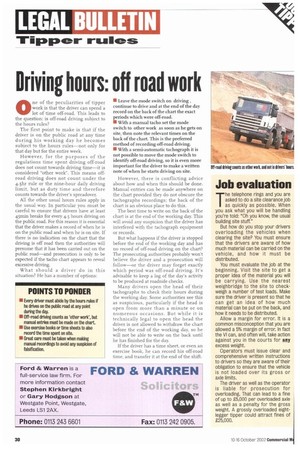Driving hours: off road work
Page 30

If you've noticed an error in this article please click here to report it so we can fix it.
One of the peculiarities of tipper work is that the driver can spend a lot of time off-road. This leads to the question: is off-road driving subject to the hours rules?
The first point to make is that if the driver is on the public road at any time during his working day he becomes subject to the hours rules—not only for that day but for the entire week.
However, for the purposes of the regulations time spent driving off-road does not count towards driving time—it is considered "other work", This means offload driving does not count under the 4.5hr rule or the nine-hour daily driving limit, but as duty time and therefore counts towards the driver's spreadover.
All the other usual hours rules apply in the usual way. In particular you must be careful to ensure that drivers have at least 45min breaks for every 4.5 hours driving on the public road. For this reason it is essential that the driver makes a record of when he is on the public road and when he is on site. If there is no indication on the chart that the driving is off road then the authorities will presume that it has been carried out on the public road—and prosecution is only to be expected if the tacho chart appears to reveal excessive driving.
What should a driver do in this situation? He has a number of options: • Leave the mode switch on driving, continue to drive and at the end of the day record on the back of the chart the exact periods which were off-road.
• With a manual tacho set the mode switch to other work as soon as he gets on site, then note the relevant times on the back of the chart. This is the preferred method of recording off-road driving.
• With a semi-automatic tachograph it is not possible to move the mode switch to identify off-road driving, so it is even more important for the driver to make a written note of when he starts driving on site.
However, there is conflicting advice about how and when this should be done. Manual entries can be made anywhere on the chart provided they do not obscure the tachographs recordings: the back of the chart is an obvious place to do this.
The best time to write on the back of the chart is at the end of the working day. This will avoid any suspicion that the driver has interfered with the tachograph equipment or records.
But what happens if the driver is stopped before the end of the working day and has no record of off-road driving on the chart? The prosecuting authorities probably won't believe the driver and a prosecution will follow—or the driver may forget exactly which period was off-road driving. It's advisable to keep a log of the day's activity to be produced at roadside checks.
Many drivers open the head of their tachographs to check their hours during the working day. Some authorities see this as suspicious, particularly if the head is open from more than a minute or on numerous occasions. But while it is technically legal to open the head the driver is not allowed to withdraw the chart before the end of the working day, so he will not be able to write on the back until he has finished for the day.
If the driver has a time sheet, or even an exercise book, he can record his off-road time, and transfer it at the end of the shift.




































































































































































